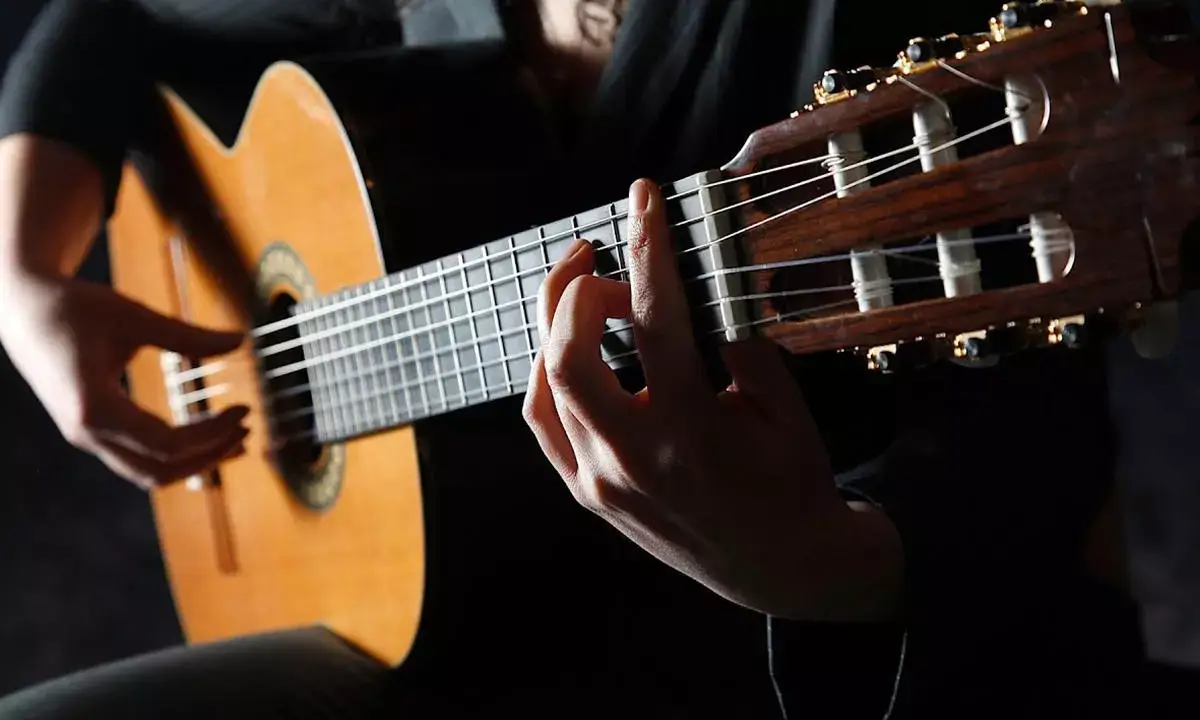Flamenco music, deeply rooted in Spanish culture, is a vibrant and expressive art form unlike any other. At its heart lies the flamenco guitar, which provides the rhythmic pulse and harmonic foundation of the genre. These guitars are specially crafted to produce flamenco’s distinctive sound and to support its dynamic, percussive playing style.
Here’s an expanded look at some of the world’s finest flamenco guitars:
The Best Flamenco Guitars in the World
Conde Hermanos AF25
The Conde Hermanos AF25 truly embodies the essence of a top-tier flamenco guitar. Your description perfectly captures its core characteristics:
-
Handmade Craftsmanship: This is paramount. Conde Hermanos, stemming from the legendary Domingo Esteso workshop, has a long lineage of master luthiers. Each instrument is meticulously crafted by hand, a process that imparts a unique character and responsiveness simply not achievable with mass production. This dedication to traditional methods ensures a level of detail and nuance in construction that directly translates to the guitar’s voice and playability.
-
Solid Spruce Top (often German Spruce): Spruce is a classic choice for guitar tops, particularly for instruments requiring clarity and projection. German spruce, specifically, is highly prized for its stiffness-to-weight ratio, which allows for a powerful, immediate attack and excellent sustain, while still maintaining a bright, vibrant tone. The «outlined grain, straight and smooth» mentioned in some descriptions of Conde spruce tops indicates a high-quality selection of wood, crucial for optimal sound production.
-
Indian Rosewood Back and Sides: While traditional flamenco guitars often use cypress for a brighter, more percussive sound («blanca» guitars), the use of Indian rosewood signifies a «negra» flamenco guitar. Rosewood, denser than cypress, contributes to:
- Increased Sustain: Notes ring out longer.
- Richer Overtones: The sound is more complex and harmonically rich.
- Greater Volume and Projection: The denser wood pushes more air, making the guitar louder and more capable of filling large spaces. This is especially important for concert performers who need to project over other instruments or in larger venues.
- «Bright, sharp, and resonant sound»: This description holds true for the rosewood Conde. While rosewood adds depth, the overall Conde voicing, combined with the spruce top, still maintains that essential flamenco «attack» and brilliance.
-
«Cutting through the percussive elements of flamenco»: This is a critical point. Flamenco involves strong rhythmic elements, including golpe (finger tapping on the soundboard), rasgueados (strumming patterns), and palmas (hand clapping). A great flamenco guitar needs to have enough clarity and definition in its sound to stand out against these percussive layers, rather than getting lost. The AF25’s bright and sharp characteristics excel at this.
-
Incredible Projection and Clarity: This is a hallmark of high-quality Conde Hermanos guitars. Their ability to project sound with exceptional clarity means that every note, every nuance of the guitarist’s playing, is heard distinctly. This is why they are favored by concert performers like Paco de Lucía, who famously played Conde Hermanos guitars throughout his career.
Beyond these specific characteristics, the Conde Hermanos legacy is also defined by:
- The «Media Luna» Headstock: The distinctive «half-moon» headstock shape has become an iconic symbol of the Conde name, instantly recognizable to flamenco enthusiasts.
- The «Dry, Woody, and Firm Tone»: This characteristic is frequently used to describe Conde flamenco guitars. It refers to a sound that is focused, without excessive lingering or muddiness, allowing for fast, articulate playing while retaining punch and clarity.
- Optimal Setup for Flamenco: Conde guitars are typically set up with a low string action, which is crucial for flamenco techniques. This facilitates the rapid-fire picados, tremolos, and rasgueados, providing a high degree of comfort and responsiveness for the player.
The Conde Hermanos AF25, as a «negra» model, offers a powerful, full-bodied flamenco sound that became incredibly popular, especially after Paco de Lucía popularized its use in concert settings. It represents a synthesis of traditional craftsmanship and an evolving understanding of the demands of modern flamenco performance.
Jose Ramirez 1a
The Jose Ramirez 1a is indeed a fascinating instrument, a testament to the Ramirez family’s continuous innovation and mastery in guitar building, which has deeply influenced luthiery worldwide.
-
A Crossover Legend: It’s quite rare for a single model to be so highly regarded by both classical and flamenco guitarists. This speaks volumes about the Jose Ramirez 1a’s versatility and exceptional tonal qualities. While many brands specialize, Ramirez achieved a design that could satisfy the demanding requirements of both genres. This versatility is partly due to the «negra» (rosewood) construction, which gives it a fuller, more sustained sound than a traditional «blanca» flamenco guitar, making it suitable for classical repertoire while still retaining enough flamenco character.
-
Handcrafted Excellence: As you noted, the «1a» designation from Ramirez signifies their top-tier, handmade instruments crafted by master luthiers in their Madrid workshop. This commitment to traditional, meticulous craftsmanship is a cornerstone of their reputation. Each guitar benefits from generations of accumulated knowledge and skill.
-
Solid Spruce Top: The solid spruce top is a consistent feature across many high-end classical and flamenco guitars. Spruce, particularly German spruce, is prized for its high stiffness-to-weight ratio, which allows for powerful projection, clear articulation, and a vibrant, bell-like tone. It also allows the guitar to «open up» and develop richer tonal complexity over time with playing.
-
Tonewood Variations for Back and Sides: This is where the Ramirez 1a flamenco model often diverges from its classical counterpart, and where it has seen some interesting historical variations:
- Cypress (for «Flamenca Blanca»): While the Ramirez 1a is often associated with rosewood, historically, Ramirez also produced «blanca» versions of their top models using cypress for the back and sides. Cypress, being lighter and less dense, contributes to a brighter, more immediate, and very percussive sound with less sustain. This is the traditional sound of a flamenca blanca, excellent for rhythmic accompaniment and cutting through in a tablao setting.
- Indian Rosewood (for «Flamenca Negra»): The more common «1a» flamenco model, often simply referred to as «negra,» features Indian rosewood back and sides. As you mentioned, this combination creates a bright, percussive sound with excellent separation between notes. The rosewood adds a certain depth, resonance, and sustain that is less pronounced in cypress, making it well-suited for solo flamenco performance and classical crossover. This «negra» sound provides more harmonic richness and volume, appealing to concert artists.
- Brazilian Rosewood: In the past, some highly prized Ramirez 1a models (both classical and flamenco) were made with Brazilian rosewood. This wood is legendary for its tonal qualities and aesthetic beauty, offering unparalleled richness, complexity, and projection. However, due to CITES regulations and its endangered status, Brazilian rosewood is no longer commonly used in new guitar construction. Vintage Ramirez 1a guitars with Brazilian rosewood are now extremely rare and valuable collectors’ items.
-
«Bright, Percussive Sound with Excellent Separation»: This specific tonal profile is key to the Ramirez 1a flamenco. The brightness ensures the guitar cuts through, while the percussive quality is essential for golpes and rasgueados. «Excellent separation between notes» means that even in fast, complex passages, individual notes remain clear and distinct, preventing a muddy sound.
-
Responsiveness and Playability: These are paramount for any professional instrument, especially in flamenco where speed, articulation, and dynamic control are crucial. The Ramirez 1a’s design, including its bracing patterns and neck profile, contributes to its comfortable playability and immediate response to the lightest touch. The low action typically set on flamenco guitars (often resulting in a characteristic «fret buzz» or trasteo which is part of the flamenco sound) further enhances this quick response.
-
Historical Significance: José Ramírez III, in particular, was a monumental figure in guitar development. His innovations in bracing, scale length, and the pioneering use of cedar for soundboards (though spruce is common on flamenco 1a models) revolutionized classical guitar building and had a significant impact on flamenco guitar design as well. The 1a model, evolving through generations of the Ramirez family, reflects this continuous pursuit of acoustic perfection.
In essence, the Jose Ramirez 1a flamenco guitar is not just an instrument; it’s a piece of living history, embodying the artistry, innovation, and deep understanding of sound that has defined the Ramirez legacy for over a century. Its ability to marry traditional flamenco percussiveness with rich tonal depth makes it a truly exceptional and enduring choice for guitarists around the globe.
Francisco Barba
Francisco Barba was a master luthier whose instruments are now highly sought after. His guitars are celebrated for their bright, sharp sound and outstanding playability. Barba’s craftsmanship is known for creating guitars with a powerful voice and a distinct flamenco character, often exhibiting a lively and responsive feel under the fingers. Acquiring a Barba guitar today often means searching the vintage market.
Manuel Reyes
Manuel Reyes (1934-2014) of Córdoba, Spain, is considered one of the greatest flamenco guitar builders of the 20th century, alongside figures like Miguel Rodriguez and the Conde Hermanos. His guitars are not merely instruments; they are often described as having duende – that untranslatable Spanish concept of a deep, authentic, and soulful artistic expression.
Here’s an expansion on the points you’ve made, highlighting the unique characteristics of a Manuel Reyes guitar:
-
«Bright, Percussive Sound»: This is a hallmark of top-tier flamenco guitars, and Reyes’s instruments deliver it in spades. They possess a powerful initial attack, crucial for the sharp, rhythmic accents (like golpes and rasgueados) in flamenco. The sound «pops» off the strings, giving it immediacy and clarity, allowing it to cut through in a tablao setting or against vocal and dance elements.
-
«Exceptional Playability»: This is non-negotiable for professional flamenco guitarists who demand speed, precision, and comfort for extended periods of intense playing. Reyes guitars are known for their:
- Low Action: Typically set up with very low string action, which minimizes the effort required to press strings to the fretboard, facilitating rapid passages and complex techniques.
- Comfortable Neck Profile: While subjective, many players find Reyes necks to be very comfortable and conducive to fast playing without hand fatigue.
- Responsiveness: They respond immediately to the lightest touch, allowing for a wide dynamic range and nuanced expression, from delicate whispers to powerful fortissimos.
-
«Unique Warmth Despite Their Percussive Nature»: This is perhaps the most defining and sought-after characteristic of a Reyes guitar. While they possess the essential flamenco brightness and percussiveness, they also have an underlying richness and warmth that adds depth and complexity to the tone. This «warmth» can be attributed to:
- Harmonic Richness: The notes are not just clear; they are surrounded by a halo of pleasant overtones, giving the sound a beautiful resonance.
- Sustain (for a Flamenco Guitar): While not as sustained as a classical guitar, Reyes guitars often have more sustain than very traditional flamenca blanca guitars, allowing melodies to sing more expressively.
- The «Woody» Sound: Many describe Reyes guitars as having a deep, woody, almost «guttural» quality that contributes to their soulful voice.
-
«Offering a Rich Tonal Palette for Nuanced Flamenco Expression»: This warmth and complexity mean that a Reyes guitar isn’t just about raw power; it allows the guitarist to explore a wider range of emotions and textures within flamenco. It’s excellent for falsetas (melodic variations), expressive cante (singing) accompaniment, and intricate toques (guitar pieces).
-
«Highly Prized and Relatively Rare»: This is absolutely true. Several factors contribute to their scarcity and high value:
- Limited Production: As a single master luthier, Manuel Reyes produced a relatively small number of instruments during his lifetime compared to larger workshops.
- High Demand: His reputation grew steadily, and professional flamenco guitarists actively sought out his instruments.
- Artistic Legacy: Many renowned flamenco artists, including Manolo Sanlúcar, Vicente Amigo, and Paco Peña, have played or owned Reyes guitars, further cementing their legendary status.
- Aging Wood: Older Reyes guitars, made with well-aged, high-quality tonewoods (often cypress for blancas or sometimes rosewood for negras), are believed to have a more developed and resonant sound.
Construction and Materials: Reyes primarily built flamenca blanca guitars (cypress back and sides, spruce top), which are characteristic for their bright, dry, and immediate response. However, he also made flamenca negra guitars (rosewood back and sides), which offered more sustain and a richer, darker tone, appealing to concert players. Regardless of the specific wood combination, his meticulous bracing patterns and attention to detail were central to his sound.
In summary, a Manuel Reyes guitar is more than just an instrument; it’s a living conduit for the duende of flamenco. Its combination of bright percussiveness, profound warmth, and exceptional playability makes it a truly unparalleled tool for any flamenco guitarist seeking to express the deepest emotions of this passionate art form. Owning a Reyes is often considered a pinnacle for serious flamenco guitarists.
Gerundino Fernandez
Gerundino Fernandez created some of the most desired flamenco guitars in the world. His instruments are recognized for their bright, sharp sound and superb playability. Fernandez guitars are known for their raw power and authentic flamenco voice, often described as having a very «duende» (soulful) quality. They are highly responsive and can articulate the rapid-fire picados and rasgueados essential to flamenco.
Felipe Conde FP14
The Felipe Conde FP14 continues the esteemed legacy of the Conde family. This handmade flamenco guitar typically features a solid spruce top and cypress back and sides. It produces a bright, percussive sound that is ideally suited for the demands of flamenco. Felipe Conde guitars maintain the high standards of their predecessors, offering excellent projection, clarity, and the characteristic flamenco «bark.»
Arcangel Fernandez
Arcangel Fernandez is a highly respected luthier whose flamenco guitars are celebrated for their bright, sharp sound and exceptional playability. His instruments are known for their powerful projection and clear articulation, making them a favorite for both performance and recording. Arcangel Fernandez’s guitars often possess a strong, traditional flamenco voice.
Paco Santiago Marin
Paco Santiago Marin is a well-regarded flamenco guitar maker whose instruments are known for their bright, percussive sound and exceptional playability. Marin’s guitars are often praised for their balance across the registers, clear tone, and comfortable playability, allowing guitarists to execute complex flamenco techniques with ease.
Ricardo Sanchis Carpio
Ricardo Sanchis Carpio is a highly regarded flamenco guitar maker, with his instruments being among the most sought after. His guitars are recognized for their bright, sharp sound and exceptional playability. Sanchis Carpio guitars are often characterized by their robust volume and clear, articulate tone, making them excellent choices for both solo performance and accompaniment.
Manuel Adalid
Manuel Adalid is a highly respected flamenco guitar maker known for producing fine instruments that offer a bright, percussive sound and exceptional playability. Adalid’s guitars, often made with high-quality tonewoods, are celebrated for their consistency, responsiveness, and ability to deliver the dynamic range required for authentic flamenco.
These ten flamenco guitars represent some of the finest instruments available globally. While each possesses its own unique tonal nuances and playing characteristics, they all share the fundamental quality of being outstanding tools for flamenco music. Whether you’re a seasoned professional or embarking on your flamenco journey, any of these guitars would be an excellent companion, empowering you to explore the depths of this captivating musical genre.
Do you have a particular sound or playing style in mind that you’re looking for in a flamenco guitar?



